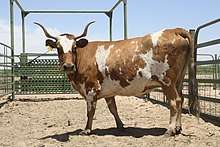Raramuri Criollo
The Raramuri Criollo is a landrace biotype of Criollo cattle indigenous to the Sierra Tarahumara or Copper Canyon region of Mexico.[1][2] In 2005 a small group was introduced to the Jornada Experimental Range (JER) in New Mexico, in the United States for scientific study.[1]


The Raramuri Criollo has characteristic lyrate horns like those of its ancestors and exhibits a wide variety of coat colors. It is generally smaller than other beef breeds, but is large among North American Criollo cattle. Raramuri Criollo are very sexually dimorphic and typically cows weigh 370 kg (816 lbs), while bulls can weigh more than 620 kg (1367 lbs). Currently, no registered breed association exists for the biotype, but they are regarded as an individual among other Criollo cattle[1].
In collaborative ethological scientific studies between the USDA-ARS's JER and New Mexico State University, Raramuri Criollo cows have consistently exhibited unique behavioral traits when compared to traditional British breeds; for instance, they tend to explore larger areas and travel further distances per day, especially in the harsh dry seasons of the American southwest[3]. These animals have also been shown to exhibit a different mothering style during early infantile calf stages, wherein cows and calves act as "followers" (young are kept closer to the mother) as opposed to "hiders" (young are hidden or kept with a guardian cow during foraging bouts) as do British crossbreds (eg. Black Baldies)[4][5]. These cattle are under continuous scientific study because these behavioral traits are suspected to be more environmentally sustainable, especially under the impending threat of climate change, than those exhibited by more traditional breeds as increased exploration, reduced water dependency, and spatial non-constraints by calving mean that cows are less likely to overuse patches of highly sensitive desert vegetation thus ensuring resilience of those biological rangeland resources[6].
See also
| Wikimedia Commons has media related to Rarámuri Criollo cattle. |
- Rarámuri people
- Criollo Cattle
- Rangeland management
References
- Anderson, Dean M., Rick E. Estell, Alfredo L. Gonzalez, Andres F. Cibils, and L A. Torell. "Criollo cattle: Heritage Genetics for Arid Landscapes." Rangelands 37.2 (2015): 62-67. Print.
- J.E. Rouse. The Criollo Spanish cattle in the Americas. University of Oklahoma Press, Norman, OK, USA (1977) 303 pp. (WorldCat)
- Peinetti, H.R., Fredrickson, E.L., Peters, D.P., Cibils, A.F., Octavio Roacho-Estrada, J. and Laliberte, A.S., 2011. Foraging behavior of heritage versus recently introduced herbivores on desert landscapes of the American Southwest. Ecosphere, 2(5), pp.1-14.
- Spiegal, S., Estell, R.E., Cibils, A.F., James, D.K., Peinetti, H.R., Browning, D.M., Romig, K.B., Gonzalez, A.L., Lyons, A.J. and Bestelmeyer, B.T., 2019. Seasonal divergence of landscape use by heritage and conventional cattle on desert rangeland. Rangeland ecology & management, 72(4), pp.590-601.
- Nyamuryekung’e et al., n.d Nyamuryekung’e, S., Cibils, A. F., Estell, R. E., VanLeeuwen, D., Steele, C., Estrada, O. R., Almeida, F. R., Gonzalez, A., and Spiegal, S. Do young calves constrain movement patterns of nursing Raramuri Criollo cows on rangeland? in review.
- Spiegal, S., Estell, R., Cibils, A.F., Browning, D.M., Peinetti, H.R., James, D., Romig, K. and Gonzalez, A., 2016, August. Can foraging behavior of Criollo cattle help increase agricultural production and reduce environmental impacts in the arid Southwest?. In Ecological Society of America Abstracts (No. 62011). Paper.